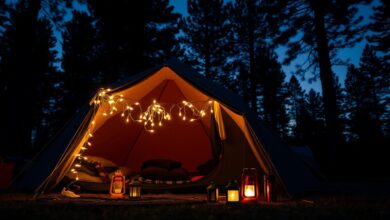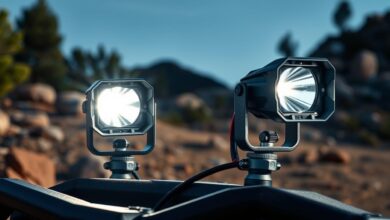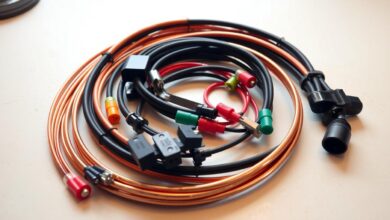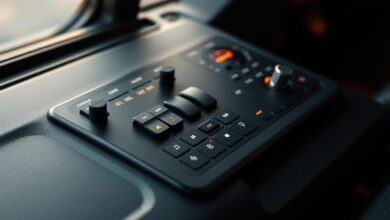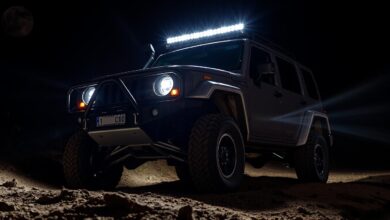Stay Connected Anywhere with the Best UHF Radios for 4WDs
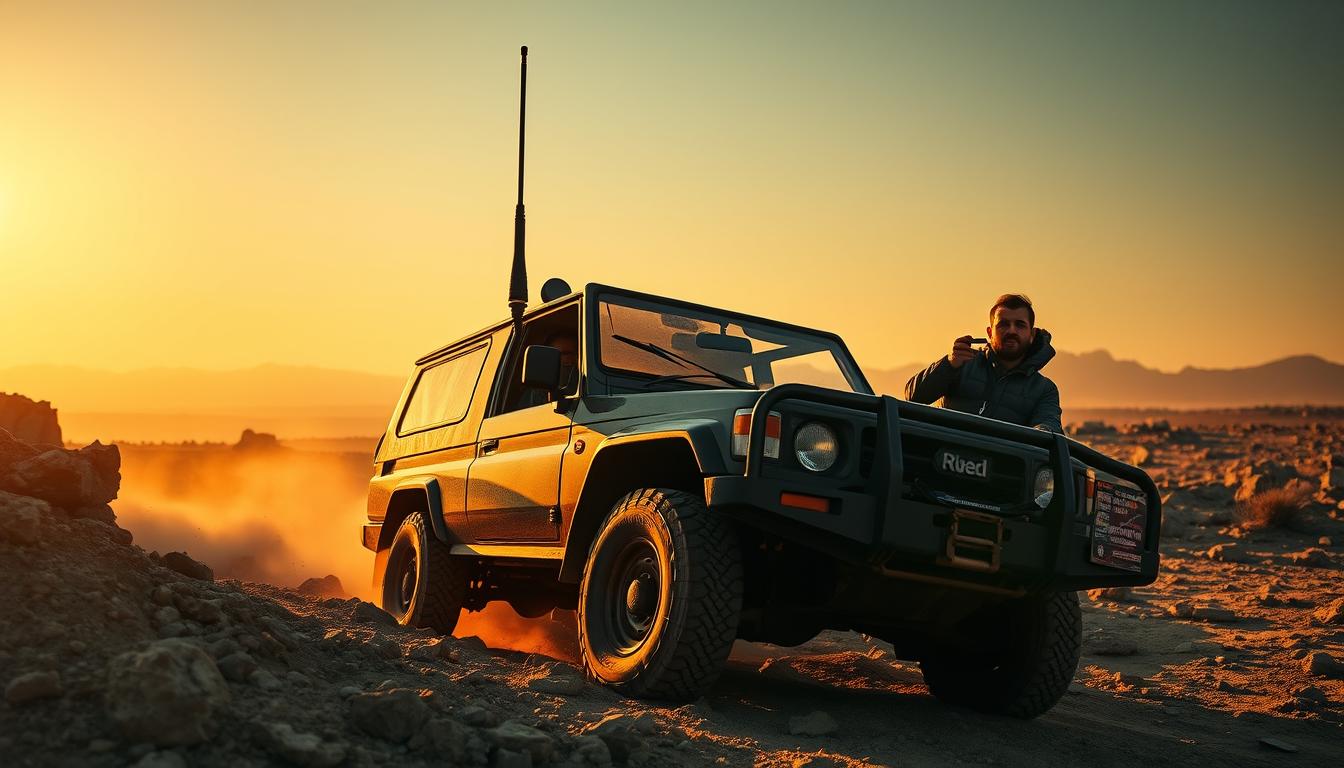
Are you ready for the unexpected when exploring remote areas with your 4WD? Good off-road communication is key for safety and teamwork. When you’re far from main roads, usual ways to talk can fail.
Rugged two-way radios are a vital tool for 4WD fans. They ensure you can talk reliably, even in tough places. For outback trips, picking the right UHF radio is essential. Check out GME’s guide on choosing the right for more on models like the TX6160X and XRS-370C4P.
Key Takeaways
- Rugged two-way radios are essential for 4WD adventures, boosting safety and connection.
- UHF radios offer dependable talk in remote and tough spots.
- Choosing the right UHF setup depends on your specific needs and travel plans.
- Popular UHF models include the TX6160X and XRS-370C4P, fitting different 4WD needs.
- Good off-road communication can be a lifesaver in emergencies.
Introduction to UHF Radios for 4WDs
For 4WD fans, UHF radios are more than a gadget. They’re key for staying in touch in the wild. UHF radios work on specific frequencies, perfect for different terrains.
They’re great for talking over long distances, even in tough terrain. This is why they’re a must-have for 4WD adventurers. They often find themselves in places far from phone signals.
What Makes UHF Radios Essential?
UHF radios are vital for many reasons. They let you talk without needing mobile phone networks, which often don’t work in the bush. They also help groups stay connected, even when they’re far apart.
Reliability is a big reason why UHF radios are so important. They work well in harsh conditions and don’t get as much interference as other ways to talk.
“The right communication tool can be the difference between a successful expedition and a disastrous one.” – Experienced 4WD Adventurer
Benefits of Using UHF Radios
UHF radios offer many benefits for 4WD adventures. They make it safer, help groups work together better, and let you call for help if needed.
| Benefit | Description |
|---|---|
| Enhanced Safety | UHF radios allow for quick communication in case of emergencies, making it safer. |
| Improved Coordination | They help groups stay together by making communication easier. |
| Emergency Assistance | In emergencies, UHF radios let you call for help. |
Knowing how UHF radios work and their benefits helps 4WD fans see their value. They’re a key part of any remote adventure.
Key Features to Look for in UHF Radios
Choosing the right UHF radio is key for your 4WD adventures. Look for features that ensure you stay connected outdoors.
Range and Power Output
The range and power of a UHF radio are vital. A higher power means a longer range. But, the terrain also plays a big role.
In areas with hills or dense trees, a stronger UHF radio is needed. This keeps your signal clear.
According to GME’s insights, knowing the power and range helps choose the right UHF radio for your 4WD.
Durability and Weather Resistance
A tough UHF radio is a must for off-road travel. Look for ones that can handle dust, water, and extreme temperatures.
Reliable 4×4 radios are built to last. They withstand the roughness of adventure travel, giving you peace of mind.
Ease of Use and Installation
It’s important for a UHF radio to be easy to use. A simple interface and easy installation save time and hassle. Many modern UHF radios have LCD displays and easy mounting options.
Experts say a good UHF radio is easy to use, even in tough spots. This lets you enjoy your adventure without tech troubles.
Top UHF Radios for 4WD Adventures
The best UHF radios can make all the difference on your 4WD adventures, ensuring you’re always in touch.
Exploring the great outdoors means reliable communication is key. Here are some top UHF radios for 4WD enthusiasts.
Midland MXT115 15-Watt UHF Radio
The Midland MXT115 is a powerful 15-watt UHF radio for rugged use. It offers long-range communication and is built to withstand off-road adventures.
Key features include:
- 15-watt power output for extended range
- Rugged design for durability
- Easy to use interface
Uniden UH950S 5W UHF Radio
The Uniden UH950S is a compact and feature-rich UHF radio. It’s perfect for 4WD adventures where space is limited but communication is key.
Notable features include:
- 5-watt power output
- Compact design
- Clear audio quality
GME TX6160TP 5W Radio
The GME TX6160TP is a reliable and robust UHF radio for the Australian outback. It offers excellent communication capabilities and is built to last.
Key features include:
- 5-watt power output
- Weather-resistant design
- User-friendly interface
Here’s a comparison of these top UHF radios:
| Model | Power Output | Durability | Price Range |
|---|---|---|---|
| Midland MXT115 | 15W | Rugged | $250-$300 |
| Uniden UH950S | 5W | Compact | $150-$200 |
| GME TX6160TP | 5W | Weather-resistant | $200-$250 |
Choosing the right UHF radio for your 4WD adventures can significantly enhance your communication capabilities. Consider your specific needs and preferences when selecting from these top models.
Comparing Analog vs. Digital UHF Radios
Choosing between analog and digital UHF radios depends on your needs and where you’ll be. Each type has its own benefits and drawbacks. Knowing these is key for good off-road communication.
Understanding Analog UHF Radio Functionality
Analog UHF radios have been around for a long time. They’re simple and reliable. Durable UHF radios like these are often the go-to for many.
But, they can pick up interference and lose signal in tough terrains. This can cause static or lost communication, which is bad during emergencies.
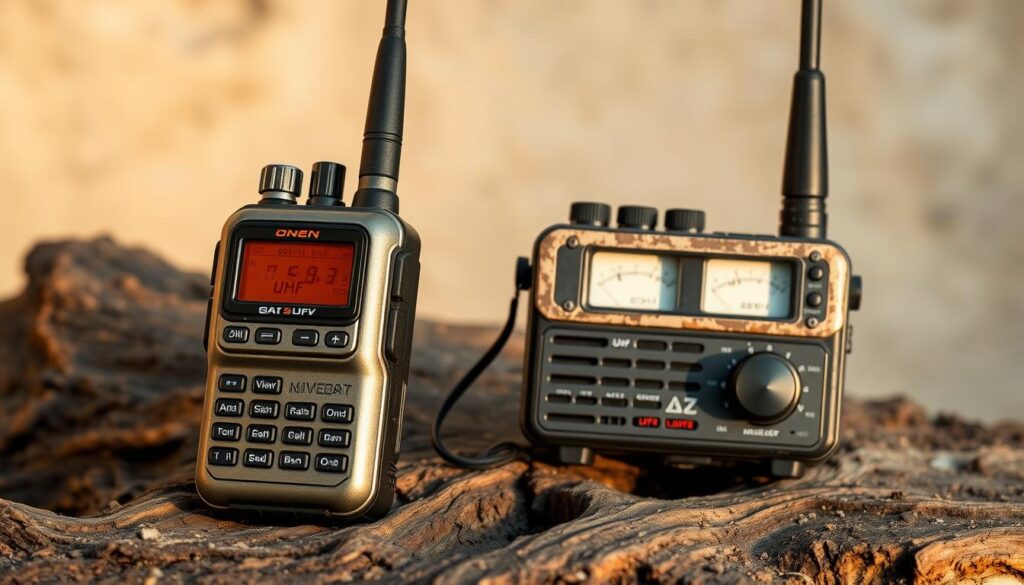
Advantages of Digital UHF Radios
Digital UHF radios have big pluses for off-road fans. They offer clearer talk with less noise. Digital signals stay strong even in tough areas.
They also have cool features like text messages and GPS sharing. These make communication better, even in remote places where other ways might fail.
But, digital radios might not work with old systems. You might need new gear or licenses.
In short, pick analog or digital radios based on your needs. Think about the terrain, how clear you need the signal, and any extra features you want.
Maintenance Tips for UHF Radios
Looking after your UHF radio is key to its performance and life span. It’s a vital tool for outdoor adventures, like 4WD trips. Keeping it in top shape is essential.
Regular Checkups for Optimal Performance
It’s important to check your UHF radio often. Look at the antenna for damage or wear. Make sure all connections are tight and corrosion-free. Test the radio to ensure it’s working right.
Key areas to focus on during your checkups include:
- Inspecting the antenna for damage or wear
- Checking all connections for security and corrosion
- Testing the radio’s transmit and receive functions
- Ensuring the battery is in good condition and properly charged
Proper Storage Solutions
Proper storage is key when your UHF radio is not in use. Keep it in a dry, cool spot, away from sunlight. A protective case can shield it from dust and damage. Remove the battery for long-term storage to avoid corrosion.
Consider the following storage tips:
- Store the radio in a dry, cool environment
- Use a protective case to prevent dust and damage
- Remove the battery during long-term storage
Here’s a comparison of different storage methods for your UHF radio:
| Storage Method | Benefits | Drawbacks |
|---|---|---|
| Protective Case | Protects from dust and physical damage | May not protect against moisture |
| Dry, Cool Place | Prevents overheating and moisture damage | May not protect against physical damage |
| Removing Battery | Prevents corrosion during storage | Requires reinstallation before use |
Enhancing Your Communication Experience
Good long-range communication is key for off-road adventures. The right accessories can make your UHF radio work better. This is true whether you’re exploring remote areas or working with your team.
Adding External Antennas
Adding an external antenna is a great way to improve your UHF radio’s performance. These antennas can make your signals stronger and clearer, even in tough terrain. When picking an antenna, think about a few things:
- Frequency Range: Make sure the antenna fits your UHF radio’s frequency.
- Gain: Antennas with more gain reach further but need more precise aiming.
- Durability: Pick an antenna that can handle rough off-road travel.
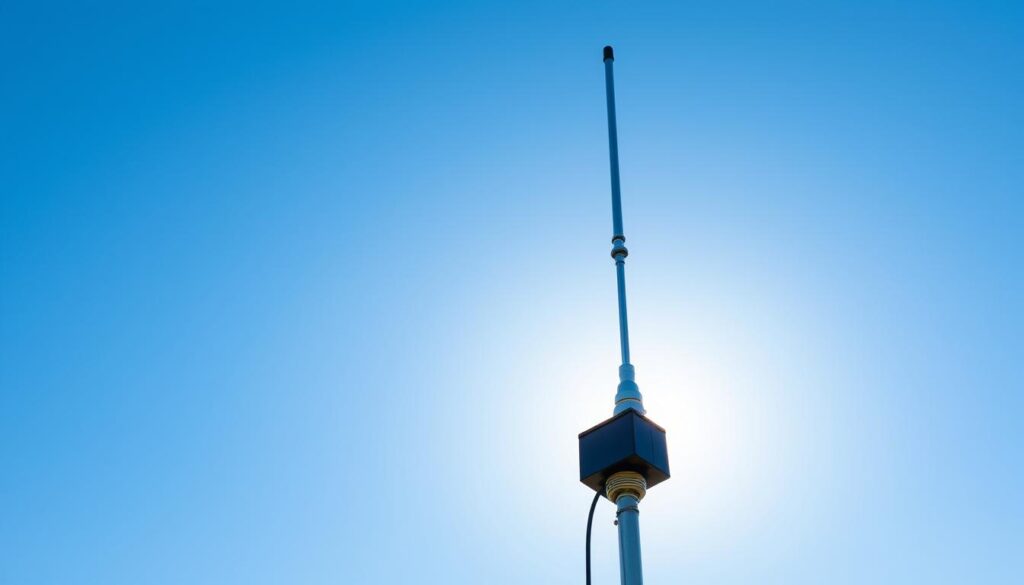
Coordinating with Accessories
Other accessories can also boost your UHF radio experience. You might want earpieces for better sound, microphones for clearer calls, or cases for protection. For more tips on picking the right UHF radio and accessories, check out this resource.
| Accessory | Benefit | Consideration |
|---|---|---|
| Earpiece | Improved reception clarity | Comfort and compatibility |
| External Microphone | Better transmission quality | Noise reduction features |
| Carrying Case | Protection during travel | Durability and accessibility |
Choosing and using these accessories wisely can greatly improve your off-road communication. This makes your adventures safer and more fun.
Troubleshooting Common UHF Radio Issues
Having trouble with your UHF radio? Don’t worry, many common problems have easy fixes. Knowing how to solve these issues can keep you connected on your 4WD adventures.
Static Noise and Signal Problems
Static noise and signal issues are common with rugged two-way radios. They can be caused by interference, poor antennas, or terrain obstacles.
To fix static noise, adjust the squelch control to block weak signals. Check your antenna connection for security and damage. Consider a higher gain antenna for better signal.
Battery Issues and Solutions
Battery problems can be a big hassle on a trip. If your UHF radio won’t hold a charge, there are a few things to check. First, clean the battery contacts for corrosion or dirt.
If the problem continues, try new batteries or recharge them if possible. Make sure the battery level indicator works right.
For reliable 4×4 radios, use top-quality batteries and follow charging tips. This can help your battery last longer and avoid issues on the trail.
The Importance of Licensing for UHF Radio Use
UHF radio licensing is more than a legal formality; it’s vital for good communication off-road. When exploring remote areas, a licensed UHF radio can keep you connected with your team. Without it, you might lose contact completely.
Understanding Licensing Requirements
Licensing rules for UHF radios differ by area and use. In Australia, the Australian Communications and Media Authority (ACMA) manages UHF radio licenses. You must know if your UHF radio needs a license to use it legally. UHF CB (Citizen’s Band) radios, often used for 4WD trips, usually don’t need a license. But other UHF radios might.
Key points to consider:
- The type of UHF radio you are using
- The frequency it operates on
- The power output of the device
How to Apply for a UHF Radio License
If your UHF radio needs a license, you’ll need to apply to the ACMA. The application is usually online and comes with a fee.
Steps to apply:
- Find out the license type you need based on your radio’s specs and use.
- Get the needed documents, like ID and radio details.
- Apply online through the ACMA website or other approved ways.
- Pay the license fee.
After getting your license, follow the rules set by the licensing body. This avoids any fines.
By following UHF radio licensing rules, you ensure legal and effective communication on your off-road adventures.
Tips for Effective Communication While Off-Roading
Good communication is key for a successful 4WD adventure, even in tough terrains in remote Australia. Rugged two-way radios or long-range communication devices help keep your group safe and in sync.
To enjoy off-roading safely, follow some important communication tips. Choose a lead vehicle to guide the group. Use clear communication rules to avoid mix-ups.
Best Practices for Group Communication
When off-roading together, setting up clear communication channels is vital. Reliable 4×4 radios help keep everyone connected. Here are some tips:
- Choose a lead vehicle to manage the group’s path.
- Agree on a communication plan, like regular updates.
- Speak clearly and to the point when talking.
For more on why communication matters in 4WD adventures, check out Club4x4. They share how good communication can make your off-roading better.
Incident Reporting Procedures
If something goes wrong, having a clear plan for reporting incidents is essential. Use your long-range communication devices to call for help if needed. Make sure everyone knows the emergency steps and how to report incidents well.
Here are some steps for reporting incidents:
- First, make sure you’re safe.
- Then, report the incident to your group and, if needed, emergency services using your devices.
- Give clear details about what happened and where you are.
By following these tips and using the right communication tools, you can make your off-roading trip better. Your group will stay connected and safe on your journey.
Real-Life Stories from 4WD Enthuisiasts
For many 4WD fans, UHF radios are a must-have on their Aussie adventures. They help navigate tough terrains and keep groups in sync. These radios are key for clear communication.
Successful Communication Adventures
A group of 4WD lovers tackled the Simpson Desert with UHF radios. They stayed in touch over long distances. When one had car trouble, they called for help, and got rescued quickly.
In the Kimberley, a group used UHF radios to plan their route. They avoided dangers and stayed safe. This made their trip a success.
Lessons Learned on the Trail
UHF radios are great, but there’s more to learn. In the Flinders Ranges, a group found out keeping batteries charged is key. It saved them when a sandstorm hit.
In Western Australia, a group learned to check their gear often. Regular checks kept their communication smooth. This was vital for their journey.
These tales show how vital UHF radios are for off-road adventures. They boost safety and help groups stay in touch. By learning from others, you can prepare better for your own trips, staying connected in remote places.
Conclusion: Stay Connected on Your 4WD Journeys
When you start your next 4WD adventure, keeping in touch is key. A tough UHF radio or a dependable 4×4 radio is vital. It helps you stay in contact with your friends.
Selecting the Right UHF Radio
Look for a UHF radio with good range, power, and durability. A rugged two-way radio can handle off-roading’s tough conditions. This way, you stay connected when it counts.
Sharing Your Experiences
Sharing your UHF radio stories helps others choose wisely. Tell of times when UHF radios worked well on 4WD trips. Also, learn from others in the 4WD community.
By picking the right UHF radio and sharing your tales, you boost the 4WD community. This makes everyone’s adventures more fun and safe.
FAQ
What is the ideal range for a UHF radio used in 4WD adventures?
The range needed for a UHF radio varies based on the terrain and your adventure’s needs. A 5-10 kilometre range is good for most off-road trips. But, you might need more range for bigger groups or very remote areas.
Are digital UHF radios worth the investment for 4WD enthusiasts?
Digital UHF radios have clear communication, resist interference well, and save battery power. They’re a good choice if you often go off-roading in busy radio areas.
How do I maintain my UHF radio to ensure it remains in good working condition?
Keep your UHF radio in top shape with regular checks and proper care. Check the battery, antenna, and connections often. Store it in a dry, cool place when not using it.
Can I use my UHF radio without a license?
In Australia, you might need a license for your UHF radio, depending on the frequencies and channels. Check with the Australian Communications and Media Authority (ACMA) to see if you need a license.
What are some best practices for group communication while off-roading?
Plan your communication clearly, including a call sign and protocol. Always check in with your group and speak clearly to avoid confusion.
How can I improve the range and performance of my UHF radio?
Boost your UHF radio’s range and performance with an external antenna and higher power output. Using accessories like a microphone or speaker can also help.
What should I do if I’m experiencing static noise or signal problems with my UHF radio?
First, check the antenna, connections, and battery for any issues. Adjust the squelch control or try a different channel. If problems continue, seek professional help or contact the manufacturer’s support.
Can I use my UHF radio in extreme weather conditions?
Many UHF radios are built to be tough and weather-resistant. But, always check your model’s specs to make sure it can handle extreme weather.
How do I choose the right UHF radio for my 4WD adventures?
Look at the range, power output, durability, and ease of use when picking a UHF radio. Research models, read reviews, and ask other 4WD enthusiasts for advice to find the best one for you.

